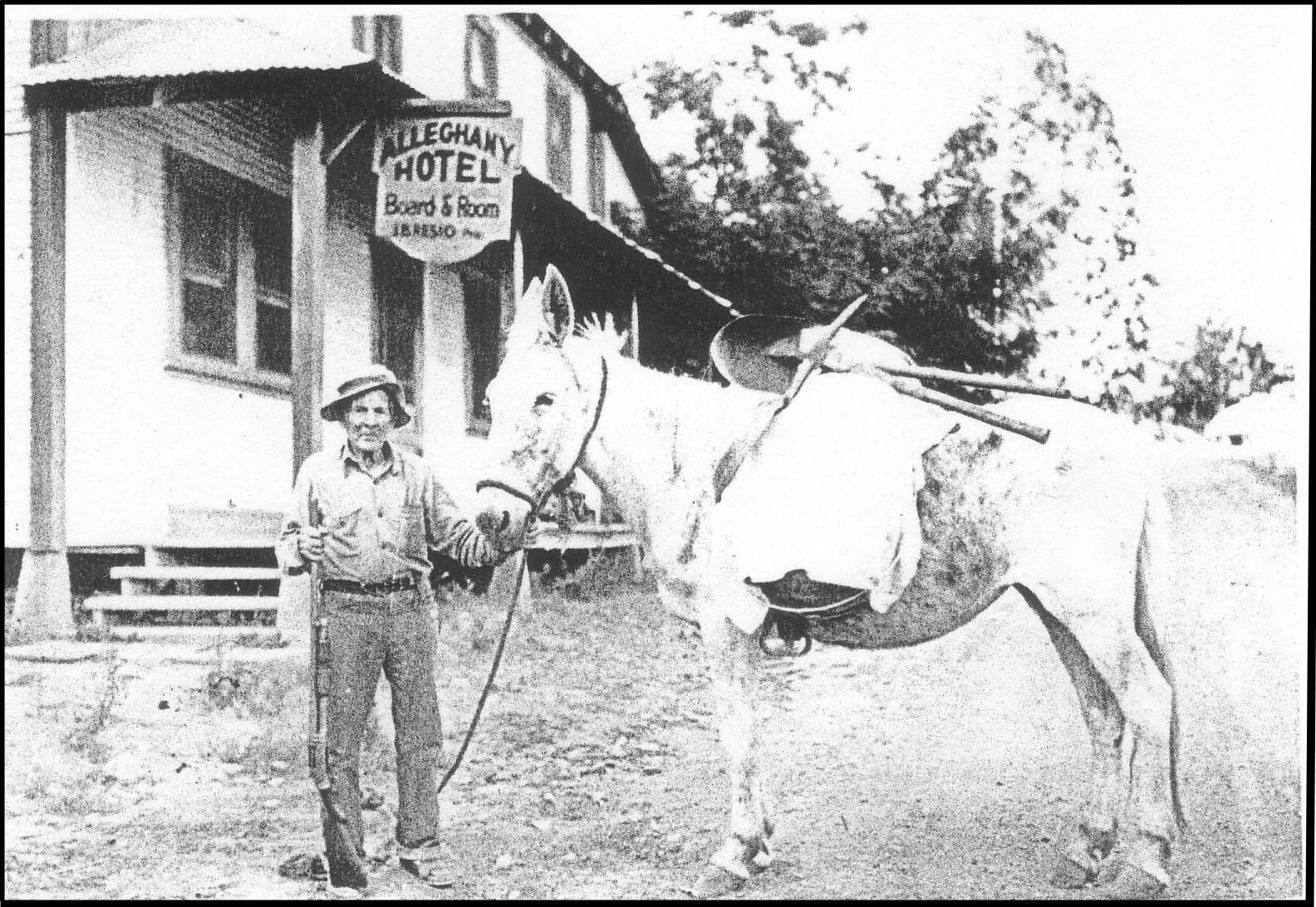Southwest Sierra #110 – Mae West, the Mule that Wandered Alleghany
July 17, 2025

Mae West and George Bealous celebrating the centennial of the California Gold Rush, 1949, Main Street in Alleghany.
The story of Mae West, the last working mule of Alleghany’s Goldmines is a favorite. For years, I’ve been trying to learn when she died. Thanks to the Bill Fuller collection, recently donated to undergroundgold.org by daughter Fran, we have the answer.
Mae West, Last of Mine Mules is Dead
The Mountain Messenger, October 28, 1954
Mae West, the big white mule owned by the Original 16-1 Mine, is dead. She collapsed in the road in front of Mrs. Olive Davies’ house and could not get up.
Lester E. Kuhfeld was notified. He came to look at her and went back to the mine, returning with Milton Sanders [in later years known by all as Uncle Milt] and Jack Eystadt in the big red truck owned by the mine. Sanders shot the mule and they tied the body behind the truck and towed it through town.
Mae West had been used in the mine to draw ore cars in times gone by. When machinery replaced the mule, she was pensioned in a barn at Tightner Mine and cared for there. In summer, she was let out to graze and could make her own way. She dearly loved apples and knew all the apple trees here.
As autumn drew on, she sensed that winter and the barn would soon face her again, and she hid out for days, only coming out nights. She was doing this lately.
It was Kuhfeld’s chore to go to the barn every day during the winter to feed and care for her. Better, perhaps, for her to go now in good weather than to die in the barn when the snow was deep.
And thus passes one of Alleghany’s institutions – the last of the mine mules, reminder of the old, prosperous days of gold mining, when a comparable gold price enabled the employment of hundreds of men in Sierra County. – end of article
The following memories were documented by me for undergroundgold.org several years ago.
Clark Rainwater (Finney Deal’s stepson) provided this account from the early 1950s:
“I was very young and did not know the name of the mine tunnel near our house, but our house was on the 16 to 1 property and we had to use a trammer to get the last 1,000 feet or so to the house. All of our groceries were brought in by an electric trammer on rails that ran right under the house. A white mule (he did not remember her name) was roaming free and would regularly go into the nearby mine portal (the Tightner Mine). The mule would stay underground for varying lengths of time and eventually wander back out. One of the miners explained to me that the mule was born in that mine and it was her home.”
Greg Hope provided this account from his dad, Al Hope.
“Mae West loved chewing tobacco. She would go into the bar and ask for a plug of chew by nuzzling one of the occupants. Once she had her plug she would go back outside. She never messed on the floor or anything. She had good manners.”
Part of the inspiration for this week’s article happened about a week ago. We were returning from a camping trip near Butte, Montana, when I spotted two white mules out in a pasture! I was so excited to see them. I asked David to pull over and I walked to the fence. They trotted to the fence and were visibly annoyed that I didn’t have any treats. One of them is quite fat, and since mules can’t have babies, it must be too many treats.
Sometimes it is difficult to tell a mule from a donkey but the key is the tail. Donkey tails are like cow tails, and mules have horse tails. Sometimes it is hard to tell a mule from a horse. Mules are usually smaller with stockier legs and longer ears, but not always! A mule is a hybrid of a female horse and a male donkey. They cannot reproduce.
Mules were preferred over horses to work in the mines for the following reasons: “Mules are smarter, have better endurance and a more workable temper. They are more sure-footed than horses, eat less, and can carry more weight pound for pound. Unlike horses, mules do not overwork themselves or put themselves in danger, making them reliable for long-term work in harsh conditions. Mules also have the ability to learn and adapt quickly to new tasks, which was crucial underground.” [sources: explorecrawforcounty.com and mulemuseum.org]
Evidently, Mae West’s stomping grounds extended across Kanaka Creek to Lafayette Ridge. Many apple trees, planted by the old-timers continue to grow there. George Hyland’s nephew Harry Eide remembered camping on Lafayette Ridge at the Irelan Mine with his uncle one summer. During the night, while they were sleeping, Mae wandered into camp, ate George’s straw hat and destroyed some of their clothing! She could be a nuisance but was loved by the community. It must have broken Uncle Milt’s heart when he had to put her down, but he knew what needed to be done and was strong enough to do it.
Featured Articles

Sheriff’s Office Accepts $60,000 Grant for New Search and Rescue Team →
December 2, 2025
Sierra County to enhance emergency response with grant-funded search and rescue team initiative.
Confusion Surrounds Release of the Plumas County Grand Jury’s Report →
December 4, 2025
WCB Considers Grant for Sierra Valley Tribal Land Purchase →
Updated November 22, 2025
Downieville Fire Auxiliary Hosts Annual “Holiday on Main” Event Saturday →
December 2, 2025
Flood Forces Temporary Closure of Sierra Hardware →
December 3, 2025